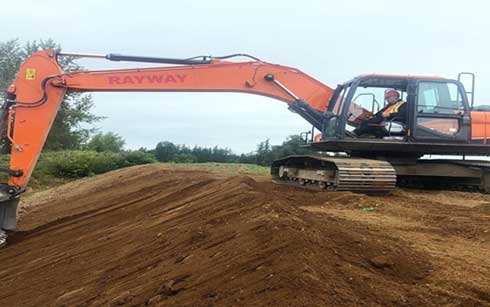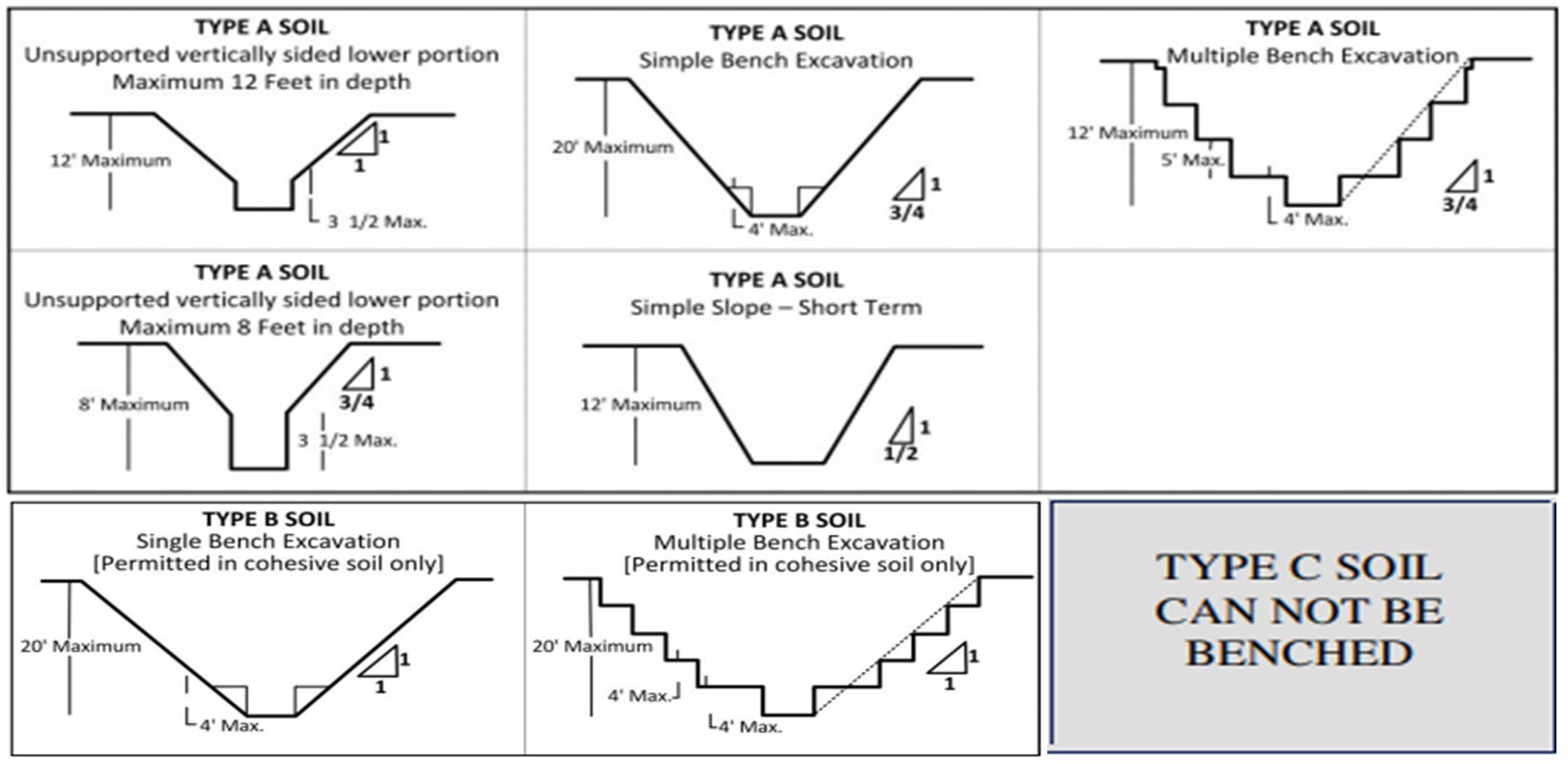Excavations Benching and Sloping Toolbox Safety Talk
Excavations
Excavations are recognized as one of the most hazardous operations in the construction industry. Excavation cave-ins can cause serious and often fatal injuries to employees. In addition to the hazards related to cave-ins, excavations are a concern on campus due to the University’s complex underground utility infrastructure. OSHA places very strict regulations governing the design of an excavation, cave-in prevention methods, and employee training. Cornell employees working in or around excavations need to be knowledgeable of these safety requirements.
General Requirements for All Excavations
- All employees working in an excavation must receive initial training.
- A competent person must be clearly identified for all excavations. This person must be knowledgeable in assessing soil conditions, the use of protective systems, and OSHA requirements.
- Before beginning excavation, establish the locations of underground and overhead utilities and services.
- When applicable contact utility companies and advise them prior to the start of excavation
- Use Personal Protective Equipment:
- Wear hard hat, safety glasses, safety gloves, high-visibility vest and safety shoes
- Do not permit people underneath the loads of lifting or digging equipment.
- When hazardous atmospheric conditions exist or we can reasonably expect them to exist, test and control the atmosphere to prevent exposure to harmful levels.
- Keep surcharge loads at least 2 feet from trench edges.
- Keep heavy equipment away from trench edges.
- Precautions must be taken to ensure vibrating equipment/vehicular traffic does not cause a cave-in.
- Employees working in trenches 4 feet deep or more should have an adequate and safe means of exit, such as ladders, steps or ramps available at no more than 25 feet of lateral travel.
- Do not work in an excavation if there is accumulated water unless necessary safety precautions are followed.
- The Daily Trenching/Excavation Log must be completed, and a copy must remain on site.
- If conditions change in or around the excavation, employees must exit the excavation and a competent person must re-inspect and give approval for employees to re-enter.
Soil Classification
An adequate identification of the type of soil is necessary through visual and manual tests to identify the correct solution of the protection system. The type of soil will determine the trench protection system to be used. Any time the site conditions change the soil will need to be reevaluated. The soil type must be identified by the competent person on site.
- Stable Rock are defined as solid mineral matter that can be excavated with vertical sides which remain intact while exposed.
- Type A soils are defined as cohesive soils with an unconfined compressive strength of 1.5 tons per square foot (tsf) or greater (i.e. clay, silty clay, sandy clay, clay loam and cemented soils)
- Type B soils are defined as cohesive soil with an unconfined compressive strength of 0.5 tsf or greater but less than 1.5 tsf (i.e. angular gravel, silt, silt loam, and sandy loam)
- Type C soils are defined as soils with an unconfined compressive strength of 0.5 tsf or less (i.e. gravel, sand, and loamy sand)
Sloping and Benching
Sloping, benching, or other approved cave-in protection systems must be utilized in excavations 5 feet or greater in depth. For excavations greater than 20 ft depth, the slope or bench shall be designed by a registered professional engineer.
- Sloping
- Sloping means a method of protecting employees from cave-ins by excavating to form sides of an excavation that are inclined away from the excavation so as to prevent cave-ins.
| Soil Type | Height/Depth ratio | Slope Angle |
|---|---|---|
| Stable Rock | Vertical | 90 degrees |
| Type A | Maximum allowable slope of 3/4:1 | 53 degrees |
| Type B | Maximum allowable slope of 1:1 | 45 degrees |
| Type C | Maximum allowable slope of 1 1/2:1 | 34 degrees |
Benching
Benching is a method of protecting employees from cave-ins by excavating the sides of an excavation to form one or a series of horizontal levels or steps, usually with vertical or near-vertical surfaces between levels. There are two basic types of benching, simple and multiple. The type of soil determines the horizontal to vertical ratio of the benched side. As a general rule, the bottom vertical height of the trench must not exceed 4 ft for the first bench. Subsequent benches may be up to a maximum of 5 ft vertical in Type A soil and 4 ft in Type B soil to a total trench depth of 20 ft. All subsequent benches must be below the maximum allowable slope for that soil type. For Type B soil the trench excavation is permitted in cohesive soil only. Type C soil is not permitted to be benched at any time.




